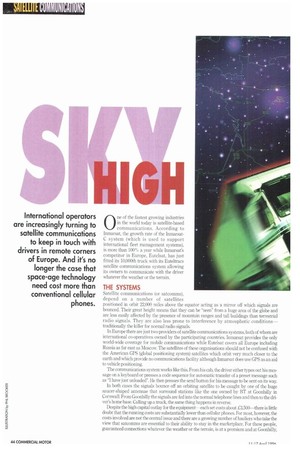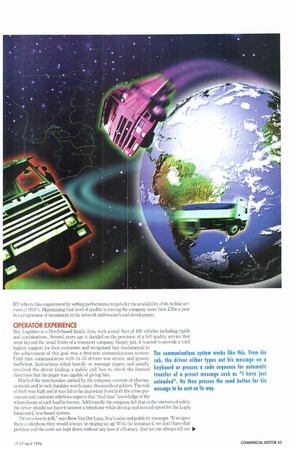0 ne of the fastest growing industries in the world
Page 54

Page 55

Page 56

If you've noticed an error in this article please click here to report it so we can fix it.
today is satellite-based communications. According to Inmarsat, the growth rate of the InmarsatC system (which is used to support international fleet management systems), is more than 1000 a year while Inmarsat's competitor in Europe, Eutelsat, has just fitted its 10,000th truck with its Euteltracs satellite communications system allowing its owners to communicate with the driver whatever the weather or the terrain.
THE SYSTEMS
Satellite communications (or satcomms), depend on a number of satellites positioned in orbit 22,000 miles above the equator acting as a mirror off which signals are bounced. Their great height means that they can be "seen" from a huge area of the globe and are less easily affected by the presence of mountain ranges and tall buildings than terrestrial radio signals. They are also less prone to interference by atmospheric conditions traditionally the killer for normal radio signals.
In Europe there are just two providers of satellite communications systems, both of whom are international co-operatives owned by the participating countries. Inmarsat provides the only world-wide coverage for mobile communications while Eutelsat covers all Europe including Russia as far east as Moscow. The satellites of these organisations should not be confused with the American GPS (global positioning system) satellites which orbit very much closer to the earth and which provide no communications facility although Inmarsat does use GPS as an aid to vehicle positioning.
The communications system works like this. From his cab, the driver either types out his message on a keyboard or presses a code sequence for automatic transfer of a preset message such as "I have just unloaded". He then presses the send button for his message to be sent on its way.
In both cases the signals bounce off an orbiting satellite to be caught by one of the huge saucer-shaped antennae that surround stations like the one owned by BT at Goonhilly in Cornwall. From Goonhilly the signals are fed into the normal telephone lines and then to the driver's home base. Calling up a truck, the same thing happens in reverse.
Despite the high capital outlay for the equipment each set costs about r3,500 there is little doubt that the running costs are substantially lower than cellular phones, For most, however, the costs involved are not the central issue and there are a growing number of hauliers who take the view that satcomms are essential to their ability to stay in the marketplace. For these people, guaranteed connections whatever the weather or the terrain, is at a premium and at Goonhilly, WI' reflects this requirement by setting performance targets for the availability of its mobile services at 99.9%. Maintaining that level of quality is costing the company more than .E3bn a year in a programme of investment in the network and research and development,
OPERATOR EXPERIENCE
Nov Logistics is a Dutch-based family firm, with a total fleet of 100 vehicles including rigids and combinations.. Several years ago it decided on the provision of a full quality service that went beyond the usual limits of a transport company. Simply put, it wanted to provide a total logistic support for their customers and recognised that fundamental to the achievement of this goal was a first-rate communications system. Until then cotnmunication with its 55 drivers was erratic and grossly inefficient. Instructions relied heavily on message pagers and usually involved the driver finding a public call box to check the limited directions that the pager was capable of giving him.
Much of the merchandise carried by the company consists of pharmaceuticals and hi-tech durables worth many thousands of gilders. The risk of theft was high and it was felt to be important from both the crime prevention and customer relations aspects that "real time" knowledge of the whereabouts of each load be known. Additionally the company felt that in the interests of safety the driver should not have to answer a telephone while driving and instead opted for the Logiq Inmarsat-C text-based system.
"Drivers love to talk," says Rene Van Der Laan, Noy's sales and publicity manager. "If we gave them a telephone they would always be ringing us up! With the Ininarsat-C we don't have that problem and the costs are kept down without any loss of efficiency. And we can always tell our llo• customers if there is going lobe a delay."
On this side of the Channel, the Dartfordbased haulier Euroeast moved on to the Russian scene just four years ago with six Renault Magnum, 38-tonners, four of which are fitted with a Euteltracs satellite communications and positioning facility, both of which the company regards as essential.
"If the drivers are eight or nine thousand miles away a mobile phone is no use to us at all," says Barry Drew, the company's sales coordinator. "With the satphone we can relay delivery directions and other information directly on to a computer screen in the cab of the vehicle. In addition to that, the positioning system tells us exactly where the lorry is all the time and that is important to us, especially in the old Soviet Union. There is no other way for us to keep in touch with each other."
Another British company that has decided to go the satcomm route is Glasgow-based Jack Conn International. With sixteen 420hp Renault Magnums constantly on the move to Moscow, and beyond, it is important that back loads are sorted well before the driver begins his return jour
ney. Using M.'s lnmarsat-C Globetrak the driver can be informed in seconds and at a fraction of the cost of using a cellular phone.
"However many messages are sent, the cost of satphones can't be anything like as much as the mobile phones we had before," says Lesley Wreford, jack Coons finance and quality director. "We were paying out £500 a month —and that's £500 per vehicle, not for all six."
Agreeing with her, An Buchner, a reefer operator based in Almkerk in the Netherlands, has worked out that it was costing him 28.40 gilders a day (about £9) to contact his drivers via conventional telephone. Using Inmarsat-C the price dropped to 4.59 gilders (about £1.50). Further savings came from a drop in fuel costs because of less re-routeing and reduced waiting times for return loads.
But it is not simply the cost of the calls that are saved. Sun Valley Distribution runs 23 Volvo FH12s and MAN 22.422s across Europe from their base in Hereford. "I always know where my vehicles are," says Richard Sparks, "and I only need two people to run the admin office. I reckon that without the Euteltracs system I would need at least three or four people just to answer the phones." L by Patrick Hook




























































































































